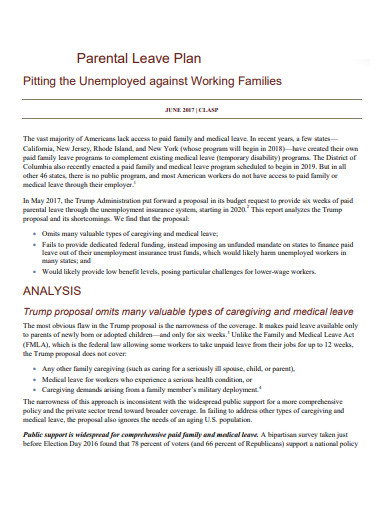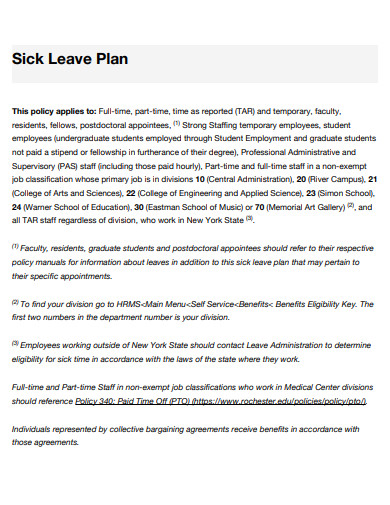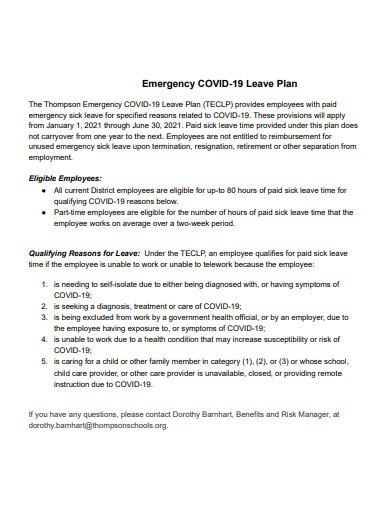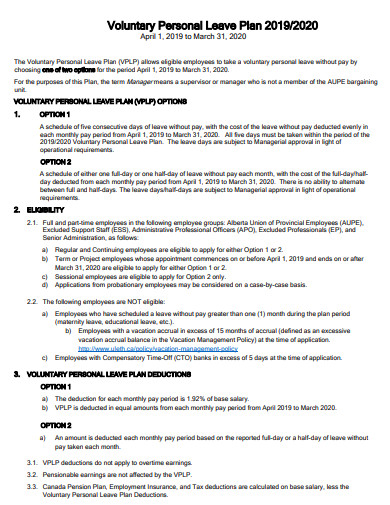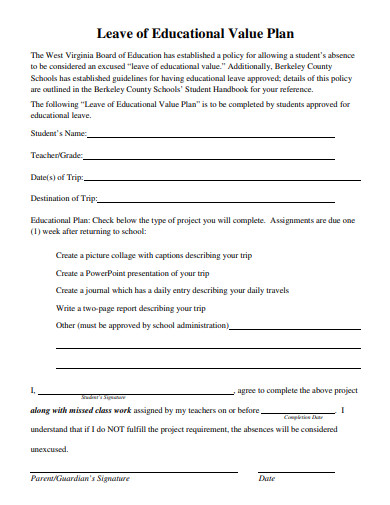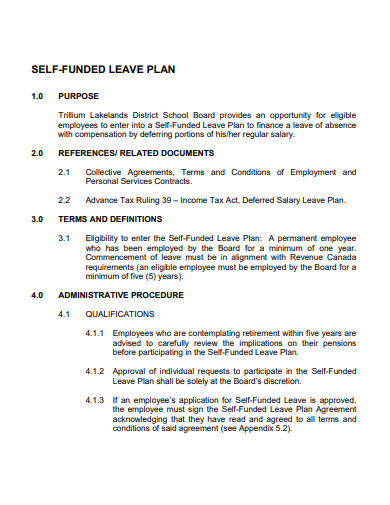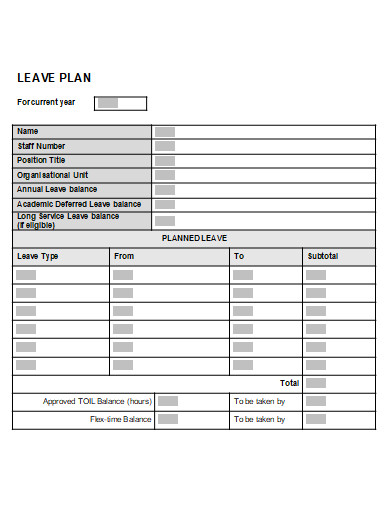It is the right of every employee to obtain leave days from their job for personal reasons. Everyone is entitled to take care of themselves and their family and sometimes instances occur where one must choose to address their concerns than their duties. That’s why companies and organizations must establish a leave plan for their employees. This will help track the days when employees take leave by calculating their leave pays and setting processes on how other employees can take over the employee taking a leave. If you’re assigned to create a leave plan, it may be quite challenging to do it if you’re not sure how to do it. This article will help you how to create a leave plan.
10+ Leave Plan Samples
1. Leave Plan

2. Voluntary Leave Plan
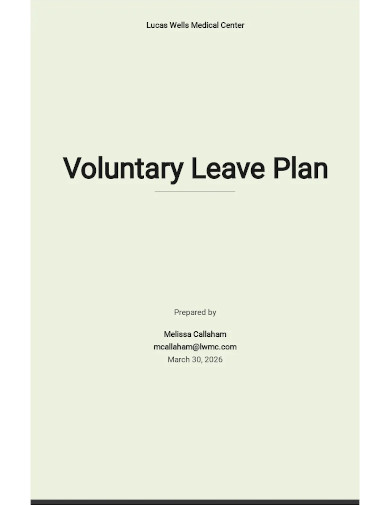
3. Vacation Leave Plan
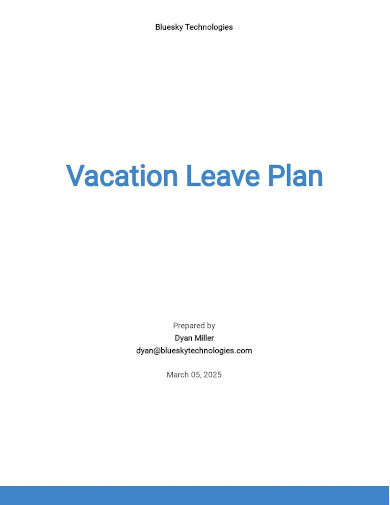
4. Leave Reduction Plan
5. Parental Leave Plan
6. Sick Leave Plan
7. Emergency COVID-19 Leave Plan
8. Voluntary Personal Leave Plan
9. Leave of Educational Value Plan
10. Self-Funded Leave Plan
11. Simple Leave Plan
What is a Leave Plan?
A leave plan is a procedure used by managers and HR personnel to track employees’ annual leave and absences efficiently. A leave plan is essential to create a tracking system for employees’ leaves.
Tips on How to Implement Your Leave Plan Efficiently
1. Create Leave Policies
When making your leave plan, you also need to implement leave policies (if there isn’t a leave policy established yet) that everyone will refer and observe to do consistently. Review your local, state, and federal labor laws and make sure your leave policies must comply with the law. Following the law will lessen complications of legal trouble. Make sure your policies are written clearly. Refer to your legal advisor if you’re not sure how policies will be written properly.
When making your leave policy, be sure to include the following details below:
- Include the holiday dates that will be observed in your organization
- How the leave days are accrued
- The systematic process for requesting time off
- What happens to unused leave days (e.g., use it or lose it vs. roll-over)
- The different types of leave you offer
Make sure to relay this information to your fellow managers and your human resource staff and conduct training to properly implement your leave policies.
2. Outline Your Leave Plan
The next thing to do is to outline your leave plan for your employees. Create two documents for your leave plan; one is for HR staff and managers for tracking leaves, and one is for employees to file their leaves.
For tracking leaves, create an annual calendar and title it as your leave plan for tracking. Create a symbol or legend to distinguish the different types of leaves that the employees will file. Make sure to mark the dates for holidays and important dates for your organization.
To make the document for your employees to file their leaves, include the following details:
- Employee’s name and their ID number
- Position title and the department they belong in
- Annual leave balance
- The type of leave the employee is filing
- The dates when the leave will take place
- The total number of leave days
- The remaining balance of their leave
- Signature line for supervisors approving the leave
The filing of leave document varies for every organization.
3. Discuss Your Leave Policies and Plan to Your Employees
When your policies and plan are complete, gather your employees and orient them about those. Communicating your leave policies and plan is a great step for them to be aware of the policies they need to follow and how to file their leaves correctly. This will also lessen complications and confusion regarding your leave process. Communicate any changes or adjustments with your policies and plan. Make sure to centralize your plan and policies to make it easier for your employees to access them.
FAQs
What is the importance of a leave plan?
There are several reasons why a leave plan is essential to establish in your organization. These are the reasons why:
- A leave plan can be used as the main source of reference for employees to track their absences and their leave dates. This will lessen the likelihood of disputes over filing leaves if there is no established leave plan created.
- It streamlines the leave process making it efficient for both employees and managers to file and track leaves.
- It also enables everyone to check the vacation and sick days of the employees so they can schedule their vacation days without compromising the daily operations of the organization.
What are the different types of leaves?
The different types of leaves are paid leaves, earned leaves, annual leaves, sick leaves, maternity leaves, paternity leaves, and bereavement leaves.
How many days of leaves are employees entitled in a year?
In the United States, employees are entitled to 21 consecutive days of annual leave.
How is leave pay calculated?
Leave pay is calculated by multiplying their regular working days by three.
After you’re done creating the leave plan, review it first for any inaccuracies before submitting the plan to your employees and have them check it and recommend any ideas to improve the plan before establishing the leave plan in your organization. To help you get started on writing the leave plan, download our free samples templates above to use as your reference.
Related Posts
FREE 8+ Maternity Resignation Samples & Templates in MS Word ...
FREE 14+ Holiday Schedule Samples and Templates in PDF Excel
FREE 7+ School Leave Application Samples in MS Word PDF
FREE 11+ Retail Daily Planner Samples in PDF MS Word
FREE 7+ Cruise Itinerary Samples in PDF MS Word
FREE 42+ Leave Letter Samples in PDF MS Word | Apple Pages ...
FREE 12+ Office Schedule Samples and Templates in PDF MS ...
FREE 8+ Leaf Templates in PDF
FREE 16+ Monthly Planner Samples & Templates in MS Word PDF ...
FREE 8+ Training Plan Samples & Templates in PDF MS Word
FREE 12+ Healthcare Marketing Plan Samples in PDF MS Word ...
FREE 8+ Sample Compensation Analysis Templates in PDF
FREE 10+ Employee Attendance Policy Samples in PDF MS Word
FREE 13+ Sample Medical Leave Forms in PDF MS Word
FREE 10+ Notice of Return to Work Samples [ Leave, Ability, Intent ]


